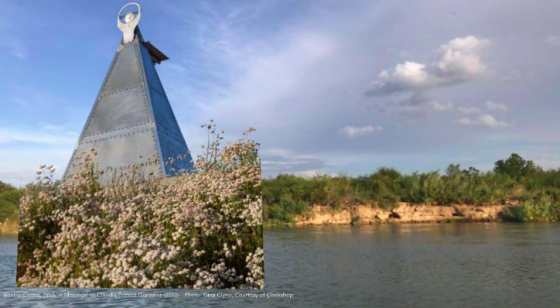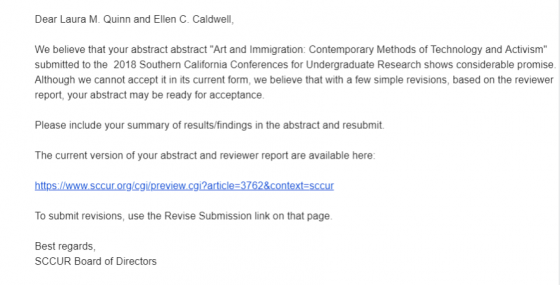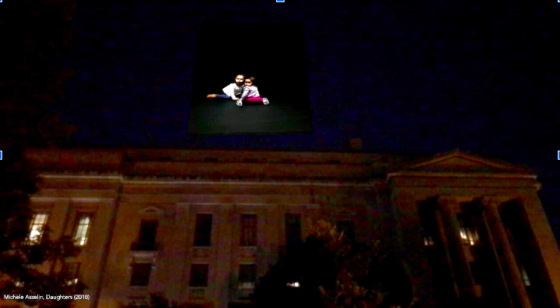Student Voices: Misadventures in Undergraduate Research
Editor’s Note: This week’s post is part of AHTR’s series “Student Voices” where undergraduates reflect on their learning experiences. We encourage students to use this opportunity to engage in the ongoing conversation about pedagogy and current issues affecting students today. Please contact us at info@arthistorytr.org if you, or a student you know, is interested in sharing a story.
The click…click…click and humming of a slide projector fill a dark lecture hall. Images appear on the wall one by one so students can discuss the content, form, and dates of historically significant works of art. This is an experience that I’ll never know — it’s one that I’ve been told existed while some of my mentors were enrolled in undergraduate art history courses. By some twist of fate, I was lucky enough to be born at precisely the right moment in time, two years before the creation of the World Wide Web. Growing up in the ‘90s, I didn’t have an inkling of just how much information I would have at my fingertips as the 20th century quickly rolled into the 21st.
The Internet and I grew up together. Now I am an honors art history major with access to an unimaginable array of images, articles, and events. As a student, I began to ponder how technology, artists, and our devices are converging to change how we interact with art. With the help of my professor, Ellen C. Caldwell, I set out on a specific research endeavor: to address how artists are engaging viewers with migrant experiences to provoke awareness, empathy and an alternative future for a profound geopolitical crisis at the Mexico–US border. My research also focused on the rich history of social activism within the Latinx community. This history has served as a stepping stone for new technological storytelling methods surrounding migration and human rights. Ironically, there were some technological bumps along the way…
Getting Started with Research
I popped into Ellen’s office hours to discuss the possibility of presenting my paper at the Southern California Conferences for Undergraduate Research (SCCUR). It was daunting to think of myself standing in front of a full room and actually making words come out of my mouth, but I thought it would be a great learning opportunity. I knew I had Ellen’s support which was a great motivating force. I looked up the abstract guidelines through the SCCUR website to establish a starting point for my submission. I had never participated in formal research presentations outside of the classroom so I was grateful to have some resources to tap into. According to the website, I would receive comments on my abstract from a “reviewer who is familiar with [my] discipline.” That eased some of the anxieties I had discussed with Ellen. I was concerned that my topic may not be a good fit for the conference because of my humanities focus.
Abstract Submission Process
The initial submission process was relatively pain free. I created an account and input my contact information before officially uploading my abstract. I read the following: “If revisions are called for, you must read the reviewers comments and revise your abstract accordingly in order for your abstract to be accepted.” I anxiously awaited feedback, hoping that my abstract would be approved and accepted for presentation. I would have only nerves and excitement to contend with after an approval. I checked my inbox the following week and saw this automated email:
“Ok, a minor setback,” I thought. I needed to provide a more concrete summary of my findings. While this response seemed a little vague and possibly geared toward STEM disciplines, I thought I could re-work my abstract to meet the criteria. Ellen and I discussed a revision which I was able to then re-submit through the website. I received another automated follow-up email, and my heart sank — Decision: Reject Abstract. No additional information was given. This was one of the most difficult aspects of my research experience. I was hoping for more communication about how I could revise my abstract to meet expectations. The automated process was impersonal and I felt lost in the shuffle. I was quite surprised to see that the initial decision for revision was from an educator whose discipline is chemistry; in fact, almost all of the SCURR board members have a science background. This got me thinking about whether there was a space for humanities at such a research conference.
New Possibilities
With a bruised ego, I let my Honors Program Director know that I would not need the registration fee covered for the conference. She encouraged me to work with the Honors Faculty Coordinator to revise my abstract for an upcoming honors conference. A new lease on research life! I got some great feedback from her on how to flesh out my perspective to give readers a clearer picture of what my presentation would be about. This new conference handled submissions a little differently. Rather than being personally responsible for entering my abstract into the application pool, the Faculty Coordinator would submit every student’s abstract in one big batch. I emailed her my final draft in November, a week before SCCUR would go on without me, and received confirmation that she received it. Now for more waiting. November turned to December and the fall semester drew to a close. I was glad to have time away to nurse my research wounds. “Am I cut out for this?,” I wondered. “How do other people cope with rejection?” my questioning continued. At least I could focus on other things for a little while.
I sought a fresh perspective to reignite my enthusiasm for art history. The Hammer Museum in Los Angeles was showing an Adrian Piper exhibition that I finally had some time to check out (for free!). Piper’s blend of social commentary, creativity, and philosophical studies was the perfect reminder of why art historical/visual studies research is so important — in my own life and beyond. We need to be having conversations about race, gender, and equity. Of course, the conversations are only a starting point. But I believe these discussions are catalysts for action, as I’ve seen among my peers and educators.

Adrian Piper: Concepts and Intuitions, 1965-2016 Installation view, Hammer Museum, Los Angeles, October 7, 2018–January 6, 2019. Photo: Brian Forrest via the Hammer Museum.
The Presentation That Almost Was
By this time, spring semester was in full swing but I hadn’t heard back about the honors conference. I was feeling a little nervous. I emailed the Faculty Coordinator for an update, but when my phone rang several minutes later I had a feeling it wasn’t great news. “Hi, Laura?” It was the Faculty Coordinator explaining and profusely apologizing that my abstract submission had gotten lost in her email inbox somehow. While she had sent me a confirmation of receipt, it had never been submitted for consideration along with the other students’ abstracts. Once again, Ellen was there with a listening ear. She encouraged me to explore more opportunities.
I was still pondering whether there was adequate space for humanities research within undergrad conferences. It was now six months later, and I was truly curious about the presentations that had been held at SCCUR. How were the humanities and social sciences represented? I decided to do a little poking around to learn more about the research that was presented back in November. I discovered some enthralling topics — Language as a Tool of Colonization in Schools in Senegal; How Cross Culture Food Helped Overthrow Apartheid in South Africa; “I am the Only One”: Educators’ Experiences Working with Undocumented Students. Wow, I missed a lot of great talks! I really should have tried to attend to learn from other students’ research.
As I kept reading through the 2018 conference schedule, my eyes darted to another title. Art and Immigration: Contemporary Methods of Technology and Activism. Wait. This couldn’t be right. That was the topic I had submitted! Sure enough, I saw my and Ellen’s name listed, along with a 10:30 AM time slot for Saturday, November 17th. How could this be possible when my abstract was rejected? I was never notified that I was assigned a time slot to present my topic. The Board of Directors had wished me all the best in my research endeavors. Case closed. Maybe someone simply selected “Reject” rather than “Accept” when reviewing my abstract. Is there a better way to communicate decisions with students?
Perhaps this was a lesson in humor, irony, or in not thinking the worst of myself. I had been so disappointed when my proposal was rejected. Maybe my excitement about new interactive technology was meant to be tempered a bit. It’s true that artists and viewers can now create and interact with art like never before. Take Nancy Baker Cahill’s Augmented Reality app, 4th Wall, which superimposes large sculptures (like Beatriz Cortez’s Tzolk’in) or towering billboard-like images in a digital, site-specific exhibition called Coordinates. But because of social media, the viewer doesn’t even need to be present at the site. Most people who have seen these installations have probably seen someone else’s screenshot while scrolling through their feed on their own device. I think we need to examine the implications of our global interconnections. This is why it’s crucial not to lose sight of the humanities’ importance amidst and alongside scientific developments.

Tzolk’in Memorial for Claudia Gómez González, by Beatriz Cortez at the Mexico/U.S. Border. Photo: Gina Clyne, Courtesy of Clockshop, Coordinates photo taken by Alejandra Muñozvia via 4th Wall App
Summing Up and Looking Forward
I’m thankful for STEM and the digital progress we’ve made because of it. Developments made in STEM impact how we interact with one another within society. And the humanities help us to better understand how humans reflect and change their environment by using these new technologies. They foster critical thinking during a time when the concept of truth itself is under attack. STEM is important, no doubt, but being able to dissect and examine the ways in which humanity is shaped by scientific and cultural developments is also important.
Ellen encouraged me to think on this and brainstorm some alternative ways that undergrads could share their research. She also encouraged me to start a discussion here with Art History Teaching Resources about the challenges facing undergraduates who want to share their research.
So that brings us up-to-date. I’ve shared some of the highs and lows of this past school year… and one very big plot twist with the AHTR community. I feel so fortunate to have a professor who has gone to bat for me, but should that fall on her shoulders? Alejandra Cervantes shared about her experience as an undergraduate at College Art Association’s annual conference. Have other students fallen through the conference cracks like us? Perhaps undergraduates can link up with a mentor for these events, maybe even a student liaison who has experienced these obstacles firsthand. I would love to start a dialogue with other educators and co-students — where and how do you share your undergraduate research and how has that process been for you?



As an undergraduate research program director, and as an art historian, I found this post both encouraging (such smart younger scholars will guarantee the future of our discipline and keep it relevant), and incredibly frustrating. A well run undergraduate research conference should have reviewers in fields appropriate to the abstracts they are reviewing and a clear and timely process by which submissions are logged, submitters are notified of decisions, and conference programs and registration portals are shared with participants. The Council on Undergraduate Research (CUR) sponsors such a conference, NCUR, which is interdisciplinary and very well organized. Next year it will be hosted by Montana State University in Bozeman, MT. Within art history and studio art, our students at Utah State have had good experiences with SECAC (which is Chattanooga, TN, at UT Chattanooga in October 2019). The good news is that with Virginia Spivey’s support, a bunch of us who are art historians involved in UR are organizing some events for CAA 2020 that will focus on undergraduate researchers and their mentors. If you’re looking for funding to travel to a conference, CUR’s Division of Arts and Humanities also has two student travel grants, one that specifically targets NCUR and Posters on the Hill (a lobbying event also organized by CUR), and another, endowed by the lovely Joe Trimmer of Ball State, that supports students traveling to national and international student and professional conferences. Check out the CURAH blog here: http://curartsandhumanities.org/blog/.
Art student here! Dealing with this type of rejection is harsher than I’d imagined before enrolling in a humanities course (even though I thought of myself thick-skinned before actually going through art school. Now, not so much haha). Although I get that exact feeling of encouragement when I see inspiring artwork (especially in person). Great article, by the way!